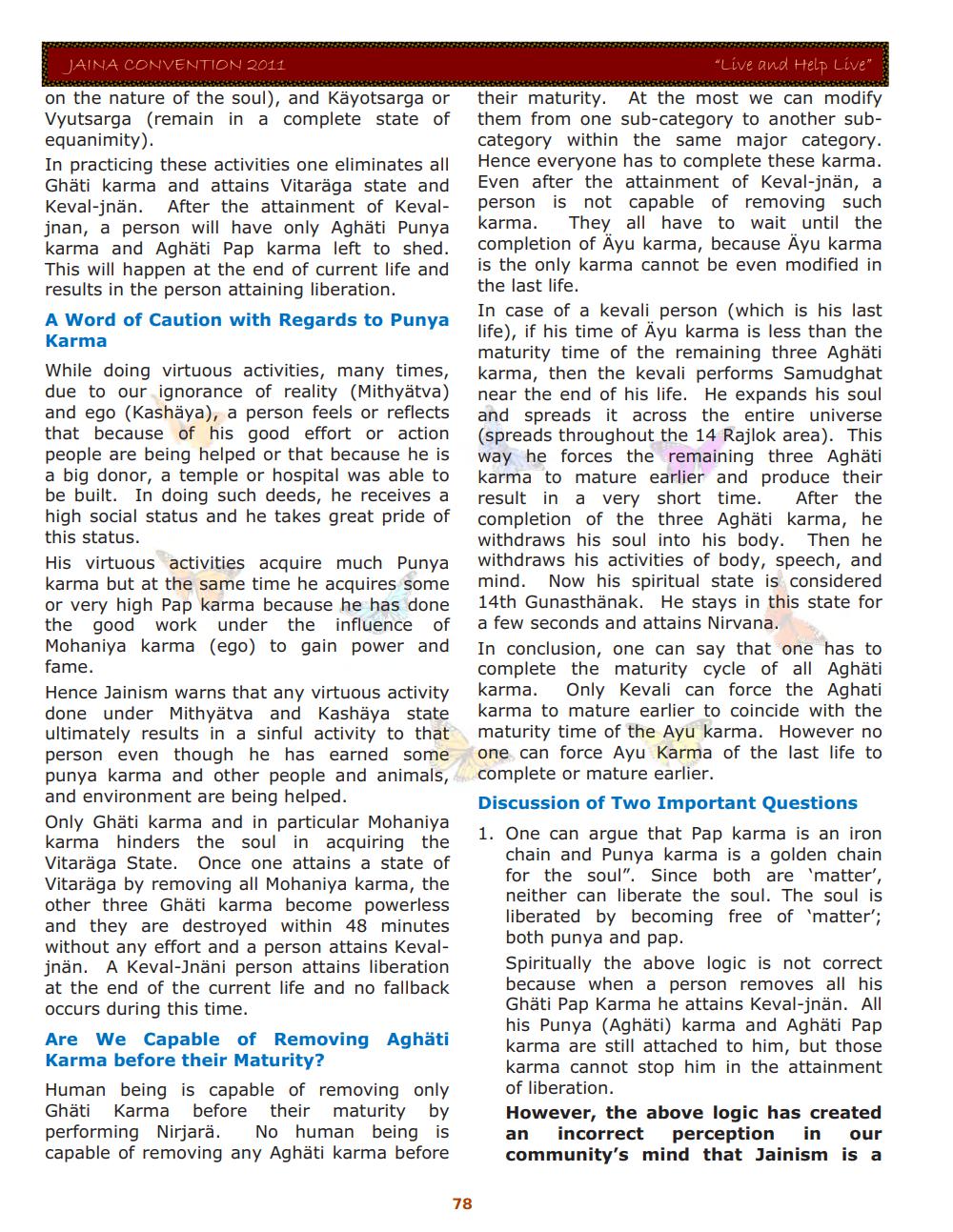________________
JAINA CONVENTION 2011
on the nature of the soul), and Käyotsarga or Vyutsarga (remain in a complete state of equanimity).
In practicing these activities one eliminates all Ghäti karma and attains Vitaräga state and Keval-jnän. After the attainment of Kevaljnan, a person will have only Aghäti Punya karma and Aghäti Pap karma left to shed. This will happen at the end of current life and results in the person attaining liberation.
A Word of Caution with Regards to Punya Karma
While doing virtuous activities, many times, due to our ignorance of reality (Mithyätva) and ego (Kashäya), a person feels or reflects that because of his good effort or action people are being helped or that because he is a big donor, a temple or hospital was able to be built. In doing such deeds, he receives a high social status and he takes great pride of this status.
His virtuous activities acquire much Punya karma but at the same time he acquires some or very high Pap karma because he has done the good work under the influence of Mohaniya karma (ego) to gain power and fame.
Hence Jainism warns that any virtuous activity done under Mithyätva and Kashaya state ultimately results in a sinful activity to that person even though he has earned some punya karma and other people and animals, and environment are being helped.
Only Ghäti karma and in particular Mohaniya karma hinders the soul in acquiring the Vitaräga State. Once one attains a state of Vitaräga by removing all Mohaniya karma, the other three Ghäti karma become powerless and they are destroyed within 48 minutes without any effort and a person attains Kevaljnän. A Keval-Jnäni person attains liberation at the end of the current life and no fallback occurs during this time.
Are We Capable of Removing Aghäti Karma before their Maturity?
Human being is capable of removing only Ghäti Karma before their maturity by performing Nirjarä. No human being is capable of removing any Aghäti karma before
78
"Live and Help Live"
their maturity. At the most we can modify them from one sub-category to another subcategory within the same major category. Hence everyone has to complete these karma. Even after the attainment of Keval-jnän, a person is not capable of removing such karma. They all have to wait until the completion of Ayu karma, because Ayu karma is the only karma cannot be even modified in the last life.
In case of a kevali person (which is his last life), if his time of Äyu karma is less than the maturity time of the remaining three Aghäti karma, then the kevali performs Samudghat near the end of his life. He expands his soul and spreads it across the entire universe (spreads throughout the 14 Rajlok area). This way he forces the remaining three Aghäti karma to mature earlier and produce their result in a very short time. After the completion of the three Aghäti karma, he withdraws his soul into his body. Then he withdraws his activities of body, speech, and mind. Now his spiritual state is considered 14th Gunasthänak. He stays in this state for a few seconds and attains Nirvana.
In conclusion, one can say that one has to complete the maturity cycle of all Aghäti karma. Only Kevali can force the Aghati karma to mature earlier to coincide with the maturity time of the Ayu karma. However no one can force Ayu Karma of the last life to complete or mature earlier. Discussion of Two Important Questions
1. One can argue that Pap karma is an iron chain and Punya karma is a golden chain for the soul". Since both are 'matter', neither can liberate the soul. The soul is liberated by becoming free of 'matter'; both punya and pap.
Spiritually the above logic is not correct because when a person removes all his Ghäti Pap Karma he attains Keval-jnän. All his Punya (Aghäti) karma and Aghati Pap karma are still attached to him, but those karma cannot stop him in the attainment of liberation.
However, the above logic has created an incorrect perception in our community's mind that Jainism is a




